Porto-North-Portugal.com
The best independent guide to north Portugal
Porto-North-Portugal.com
The best independent guide to north Portugal
Day Trip to Guimarães from Porto: Self-Guided Walking Tour 2026
Guimarães holds a unique place in Portuguese history as the birthplace of the nation itself. This remarkably preserved medieval city in northern Portugal combines centuries of heritage with an authentic atmosphere that many tourist destinations have lost.
The city's historic centre is a UNESCO World Heritage Site, where cobbled streets wind between medieval squares and past monuments that witnessed the birth of Portugal. From the imposing castle where the country's first king was born to the grand ducal palace and Gothic churches, Guimarães offers more historical charm than almost anywhere else in Portugal.
Guimarães should be visited in any extended trip to northern Portugal and can easily visited independently using the regular train service from Porto.
This guide provides everything you need for the perfect day trip to Guimarães. The first section covers practical details, transport options and insider tips, while the second section offers a detailed self-guided walking tour of the city's historic centre.
Related articles: Day trips from Porto
Highlights of a day trip to Guimarães
Castelo de Guimarães - The medieval fortress where Portugal was born, perched on a granite outcrop overlooking the city. This 10th-century castle was the birthplace of Portugal's first king and offers spectacular views from its battlements.
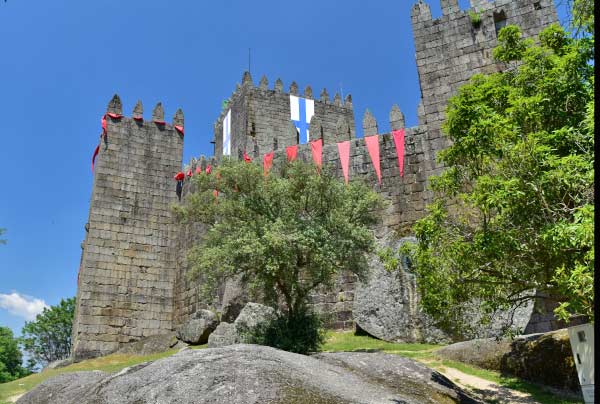
Paço dos Duques de Bragança - A striking 15th-century palace with distinctive brick chimneys inspired by French manor houses. Inside, visitors can explore over 60 rooms filled with tapestries, medieval furniture and an impressive collection of weapons.
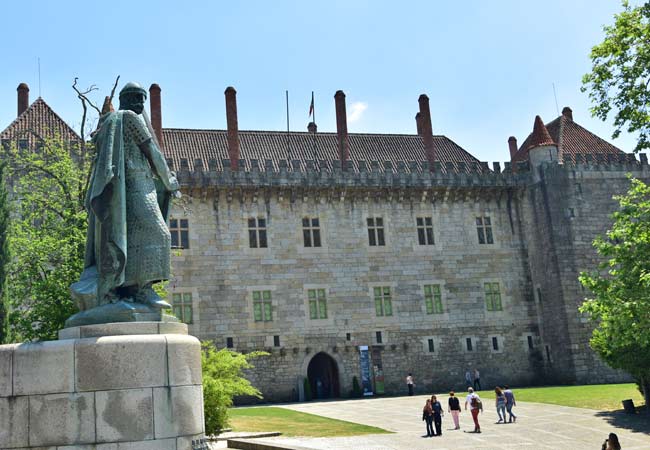
Largo da Oliveira - One of Portugal's most photogenic medieval squares, where outdoor cafés cluster around a Gothic shrine and the centuries-old olive tree that gives the square its name.
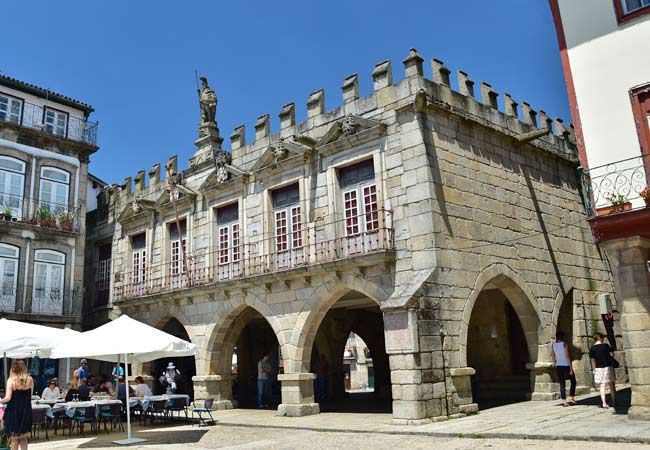
Monte da Penha - A forested hill south of the city crowned by a modernist sanctuary, accessible by cable car and offering panoramic views across the Minho region.
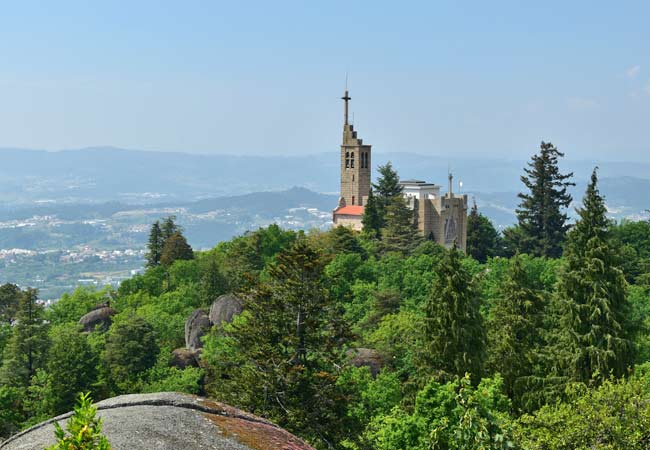
A suggested 1-day tour of Guimarães
Below is an interactive map for our suggested 1-day tour to Guimarães. The tour of the historic centre is highlighted in green, with the optional trip to Penha Hill marked in yellow.
Info: Most visitors travel to Guimarães by train and the station is situated to the south of the city. The main car park is to the north of the city and also marked on the map.
Sights of Guimarães: 1) Igreja de Nossa Senhora da Consolação 2) Largo República do Brasil 3) Igreja de Nossa Senhora da Oliveira 4) Largo da Oliveira 5) Antiga câmara municipal 6) Praça de São Tiago 7) Convento de Santa Clara 8) Igreja Nossa Senhora do Carmo 9) Paço dos Duques de Bragança 10) Igreja de São Miguel 11) Castelo de Guimarães 12) Estátua a Dom Afonso Henriques 13) Convento de Santo António dos Capuchos 14) Largo do Toural 15) "Aqui Nasceu Portugal" 16) Capela de São Francisco
The full guide to this tour is detailed at the end of this article
Guimarães, Braga or both together?
Many visitors to Porto find themselves choosing between Guimarães and Braga, the two great historic cities of the Minho region. In our opinion, Guimarães is the more characterful and interesting destination. While Braga offers more monuments and tourist sights, these are predominantly religious in nature, all of which are covered in our day trip guide to Braga.
If your schedule allows, both cities deserve individual day trips. They complement each other wonderfully, Guimarães with its medieval history and character, Braga with its baroque grandeur and religious heritage.
For independent travellers, it's too ambitious to visit both Guimarães and Braga in a single day, as each city deserves a full day of exploration. If you're limited for time, consider joining an organised tour that visits both destinations with a knowledgeable guide to show you the major sights.
Those with an extended stay in Porto should visit both Guimarães and Braga as separate day trips, along with Aveiro, the Douro Valley and Viana do Castelo.
We have worked with GetYourGuide.com for the previous seven years and some of their best tours they offer for Guimarães include:
Travel to Guimarães for a Day Trip
Getting to Guimarães is straightforward, with several transport options available from Porto and other northern cities.
By Train
The train is the most popular option for independent travellers. Direct urban trains run from Porto's São Bento station to Guimarães throughout the day. The journey takes 75-85 minutes and costs €7.10 for a return ticket (€3.55 for children).
Trains generally run hourly, with reduced service on Sundays and holidays. It's advisable to check departure times before visiting, as afternoon services can have gaps of up to two hours. The most convenient return trains are typically at 15:53 (daily) or 17:07 (weekdays) / 17:58 (weekends).
For the latest timetable, check the Comboios de Portugal (CP) website:
www.cp.pt/
(Note: This link downloads as a PDF on mobile devices)
Guimarães train station is conveniently located just 700 metres south of the historic centre - about a 10-minute walk along Avenida Dom João IV.
Related articles: Porto to Guimarães
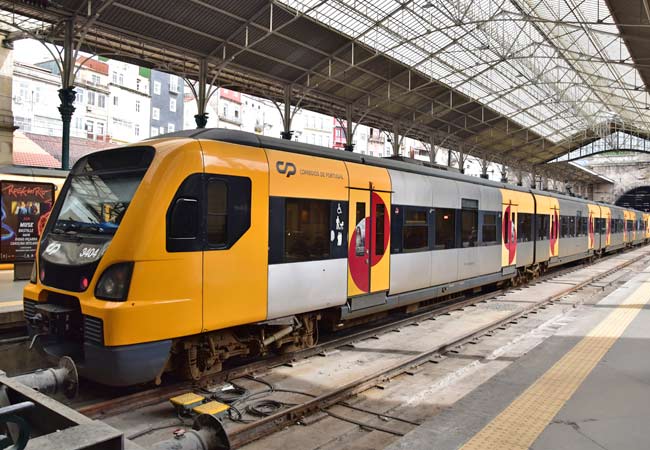
The train to Guimarães, waiting in the São Bento train station
By Car
If you're driving, Guimarães is easily accessible via the A7 motorway from Porto (50km, about 45 minutes). The main tourist car park is located north of the historic centre near the Paço dos Duques. Street parking in the historic centre is extremely limited and not recommended.
By Uber or Bolt
For groups or those preferring door-to-door service, ride-hailing apps offer a convenient alternative. Expect to pay €35-45 for the journey from Porto, depending on time of day and demand. This can be cost-effective for groups of 3-4 people.
Where to Go for Lunch in Guimarães
Guimarães excels at traditional northern Portuguese cuisine, with restaurants offering hearty portions at reasonable prices. The historic centre has numerous options, from simple tascas to more refined establishments.
Histórico by Papaboa - Located in a beautiful stone building near the castle, this restaurant serves elevated versions of regional dishes. Their vinho verde selection is excellent, and the outdoor terrace is perfect for warm days.
Solar do Arco - A local institution occupying a 17th-century manor house, specialising in traditional Minho cuisine. Don't miss their rojões (pork chunks) or the house-made desserts. Expect to pay around €15-20 for a full meal.
A Cozinha por António Loureiro - For a special lunch, this Michelin-recommended restaurant offers creative interpretations of Portuguese classics. The tasting menu is excellent value at lunch. Booking essential.
Café Oriental - Don't let the name fool you - this is a traditional Portuguese restaurant popular with locals for its daily specials. Great value with most main courses under €10. Located on the main shopping street.
Cor de Tangerina - A vegetarian-friendly option in the historic centre, offering creative salads, quiches and daily specials. Pleasant courtyard seating and good coffee too.
Taberna Dom José - A tiny tasca near Largo do Toural serving simple but delicious grilled meats and fish. No frills but authentic and incredibly cheap - perfect for budget travellers.
A suggested walking tour of Guimarães
This suggested walking tour takes you to all of Guimarães's sights and follows a route that minimises backtracking and uphill climbs. The green route covers 5.3km in total, including the walks to and from the train station, and takes approximately 4-5 hours.
For those wanting to extend their day, the optional cable car trip to Penha hill is marked in yellow on the map. This adds an additional 1.5-2 hours to your visit. Note: Zoom out to see all the points on the map.
Starting your walking tour from Guimarães train station, turn right as you exit and follow the signs toward the historic centre. At the roundabout, turn left onto Avenida Dom João IV, a pleasant tree-lined avenue that serves as your gateway to medieval Portugal. This 700-metre walk takes about 10 minutes and gradually transitions from the modern town into the historic heart.
Your first landmark is the Igreja de Nossa Senhora da Consolação (1), an elegant baroque church that perfectly introduces Guimarães's architectural heritage. The church's distinctive twin towers were actually added 90 years after the main structure was completed in 1785, creating an unusual but harmonious blend of styles. While the interior is often closed outside of mass times, the ornate façade alone merits a photo stop.
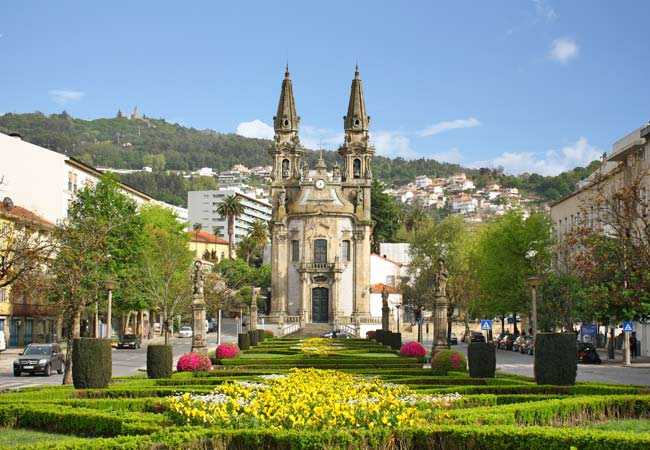
Continue along Largo República do Brasil (2), where the modern city gives way to the UNESCO World Heritage zone. This charming square marks your entry into medieval Guimarães, with traditional Portuguese pavement patterns underfoot and the first glimpses of centuries-old buildings. The square often hosts small markets on weekends, where locals sell handicrafts and regional products.
The street narrows as you approach the heart of the historic centre, emerging into Largo da Oliveira (4), arguably Portugal's most photogenic medieval square. The square takes its name from the ancient olive tree growing beside a Gothic canopy shrine, legend says this tree miraculously sprouted leaves in 1342 after being dead for years, coinciding with the installation of a new cross. Today, outdoor café tables cluster around this sacred spot, making it perfect for a morning coffee while soaking in the medieval atmosphere.
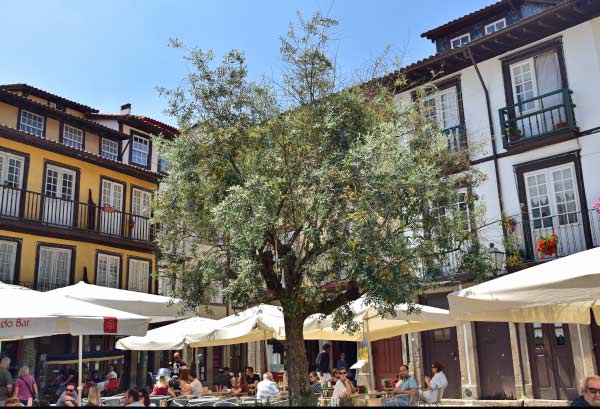
Dominating the square is the Igreja de Nossa Senhora da Oliveira (3), originally founded as a monastery in 950 by Countess Mumadona. The current Gothic structure dates from the 14th century when King João I rebuilt it in gratitude for his victory at the Battle of Aljubarrota. The church houses remarkable treasures including a silver altarpiece and the actual tunic worn by João I in battle. The adjoining monastery now contains the Museu de Alberto Sampaio, displaying an impressive collection of religious art, though many visitors find the church itself more compelling than the museum.
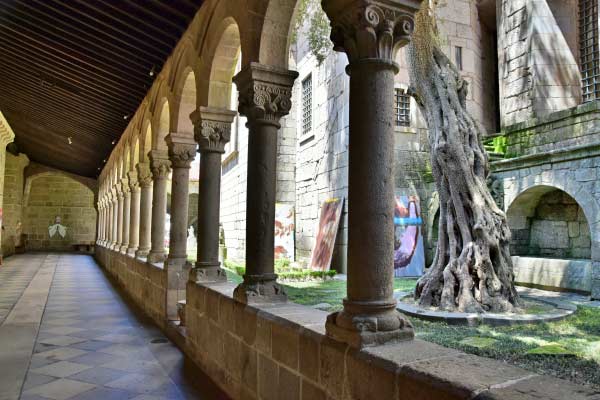
The Antiga Câmara Municipal (5) stands on the square's northern edge, its distinctive Gothic arches and crenellated roofline making it one of Guimarães's most photographed buildings. Built in the 14th century, it served as the town hall for over 500 years. The ground floor arcades once housed the town market, while council meetings took place in the chambers above.

A narrow passageway leads from Largo da Oliveira to Praça de São Tiago (6), another atmospheric square with a completely different character. More intimate than its neighbour, this square fills with restaurant tables during summer and offers some of the best dining options in the historic centre. According to legend, an image of the Virgin Mary was brought here by Saint James (São Tiago), giving the square its name.
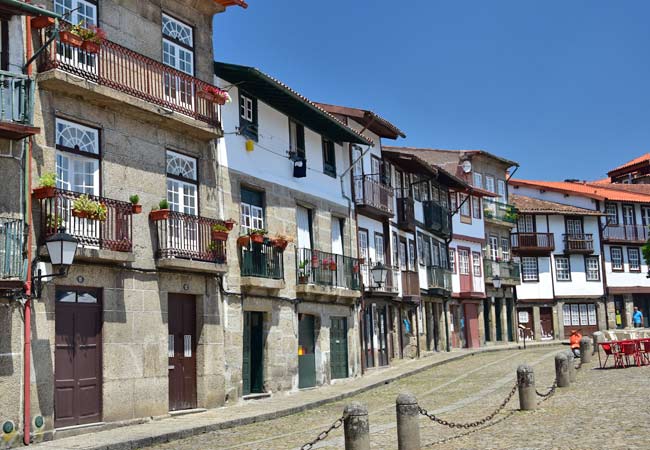
From Praça de São Tiago, follow the signs pointing toward the castle, heading uphill through increasingly ancient streets. You'll pass the Convento de Santa Clara (7), founded in the 16th century but now functioning as the town hall (Câmara Municipal). The building's transformation from convent to civic centre reflects Portugal's 19th-century dissolution of religious orders.
The route continues past the Igreja Nossa Senhora do Carmo (8), an 18th-century church with an impressively ornate baroque interior - if the doors are open, peek inside to see the gilded woodwork. The adjacent Jardim do Carmo provides a peaceful green space and good views over the city's terracotta rooftops.
The impressive Paço dos Duques de Bragança (9) dominates the hilltop with its distinctive brick chimneys and granite walls. Built in 1420 by the first Duke of Braganza, this palace shows clear French architectural influence - unusual for Portugal. The Duke had travelled extensively in Europe and wanted to recreate the sophistication of northern European courts. After centuries of abandonment, the palace was controversially but thoroughly restored in the 1930s. Today visitors can explore over 60 rooms displaying period furniture, tapestries depicting the Portuguese conquest of North Africa, and an impressive collection of weapons. Allow at least 45 minutes for the interior visit.
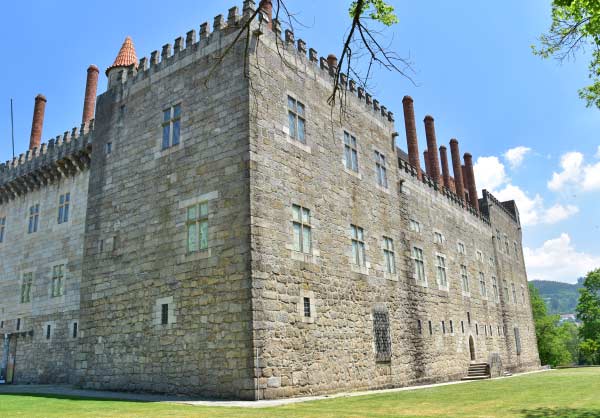
Between the palace and castle stands the tiny Igreja de São Miguel do Castelo (10), one of Portugal's most historically significant churches despite its modest size. This simple Romanesque chapel, dating from the 12th century, witnessed the baptism of Afonso Henriques, Portugal's first king. The original baptismal font still stands near the entrance, and the floor contains tombstones of medieval knights who fought in the founding battles of Portugal.
At the hill's summit, the Castelo de Guimarães (11) rises from a granite outcrop, its walls seamlessly blending with the natural rock. First built in the 10th century by Countess Mumadona to protect the monastery from Viking and Moorish raids, the castle was later expanded and strengthened. This is where Afonso Henriques was born in 1109 and where he likely proclaimed Portuguese independence in 1139. The castle's seven towers are linked by sturdy walls with a walkway along the top, offering spectacular views across the city and surrounding countryside. The central keep, added in the 13th century, can be climbed for even better panoramas.

Near the castle entrance stands the imposing Estátua a Dom Afonso Henriques (12), depicting Portugal's first king in full armour. Created by sculptor Soares dos Reis in 1887, this romantic monument has become one of Guimarães's most recognisable symbols.
On your descent from the castle, detour slightly to visit the Convento de Santo António dos Capuchos (13), a 17th-century Franciscan convent known for its small but beautiful church decorated with azulejo tiles. The convent's most fascinating feature is its tiny cloister, one of the smallest in Portugal.
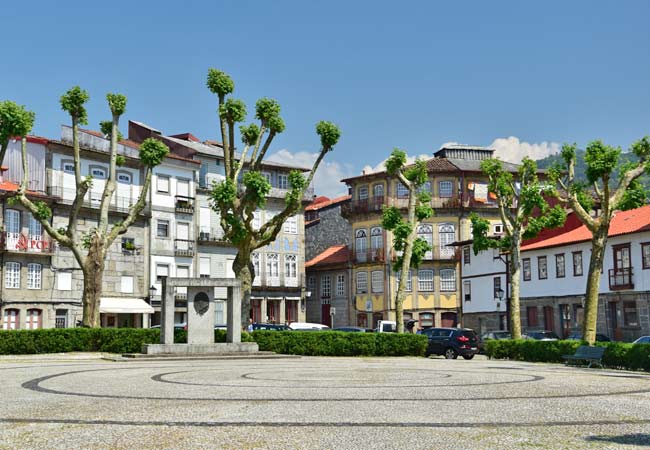
Return to the historic centre via different streets to see more of medieval Guimarães. The route leads to Largo do Toural (14), the city's main square and traditional meeting point. Originally outside the city walls, this square became the site of cattle fairs and markets from the 17th century onwards. Today it's surrounded by elegant buildings and serves as the boundary between historic and modern Guimarães.
From Largo do Toural, a short walk leads to a remaining section of the medieval walls where you'll find Guimarães's most famous inscription: "Aqui Nasceu Portugal" (15) - "Here Portugal was Born". This simple phrase, carved into the old city walls, perfectly encapsulates Guimarães's significance.
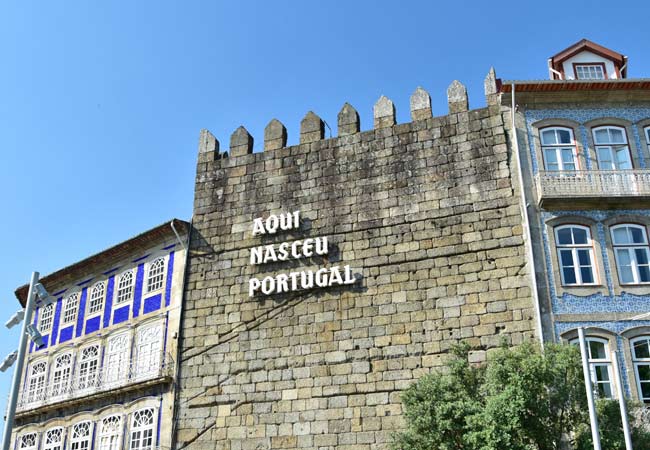
End your walking tour at the Capela de São Francisco (16), a small Gothic church that's often overlooked but contains beautiful azulejo tiles depicting the life of Saint Francis. The church faces a pleasant garden square that provides a peaceful spot to rest and reflect on your journey through Portugal's birthplace.
Extending Your Day Trip: Penha Hill
The Teleférico de Guimarães (cable car) provides a scenic 10-minute journey from the city to the summit of Penha Hill, transforming a steep 3km hike into an effortless ascent. The lower station is a 15-minute walk southeast from the historic centre - follow the signs from Largo do Toural. Cable cars depart every 20-30 minutes, with return tickets costing €4.50 and singles €2.30.
The cable car glides above dense forest, offering increasingly spectacular views as you rise to 617 metres. Operating hours vary by season (typically 10:00-18:00, extended to 19:00 in summer), so always check the schedule before making the trek to the station. Missing the last car down means a long, tiring walk back to the city.
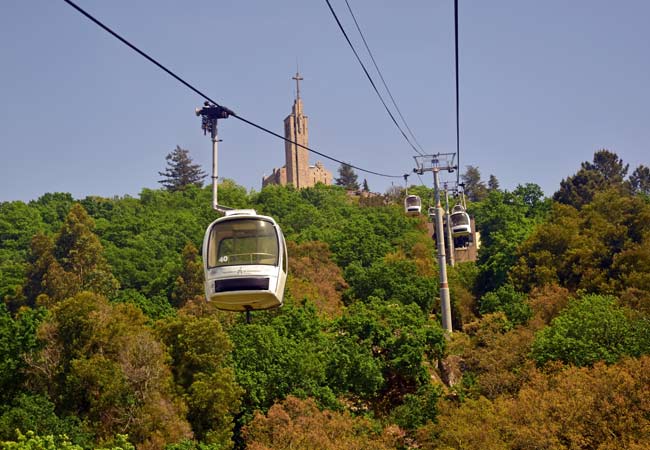
At the top, the Santuário da Penha (17) immediately commands attention. This modernist sanctuary, built between 1930-1947, seems to grow from the granite boulders themselves. Architect José Marques da Silva incorporated massive rock formations into the building's structure, creating a unique blend of nature and architecture. While the sanctuary's angular concrete form divides opinion, its integration with the mountain landscape is undeniably impressive.
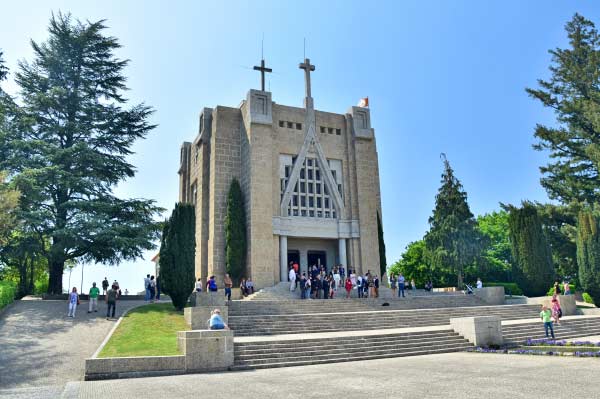
The real appeal of Penha lies in its natural setting. A network of walking paths winds through 50 hectares of forest, passing between enormous granite boulders worn smooth by centuries of wind and rain. The Monte de Santa Catarina (18) area features some of the most dramatic rock formations, including precariously balanced stones that seem to defy gravity.
For the best views, follow the signs to the summit at 613m (19). The short climb from the sanctuary is rewarded with 360-degree panoramas across the Minho region, on clear days you can see as far as the Atlantic Ocean. The Miradouro da Penha (20) offers another excellent viewpoint with benches and interpretive panels identifying distant landmarks.
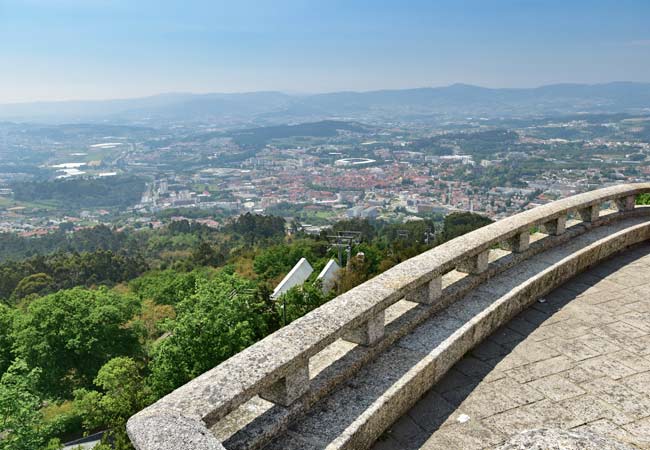
Hidden among the boulders, the tiny Gruta Ermida Nossa Senhora do Carmo (21) represents Penha's spiritual heritage predating the modern sanctuary. This cave shrine, where hermits once sought solitude, maintains an atmosphere of quiet contemplation despite the nearby tourist facilities.























